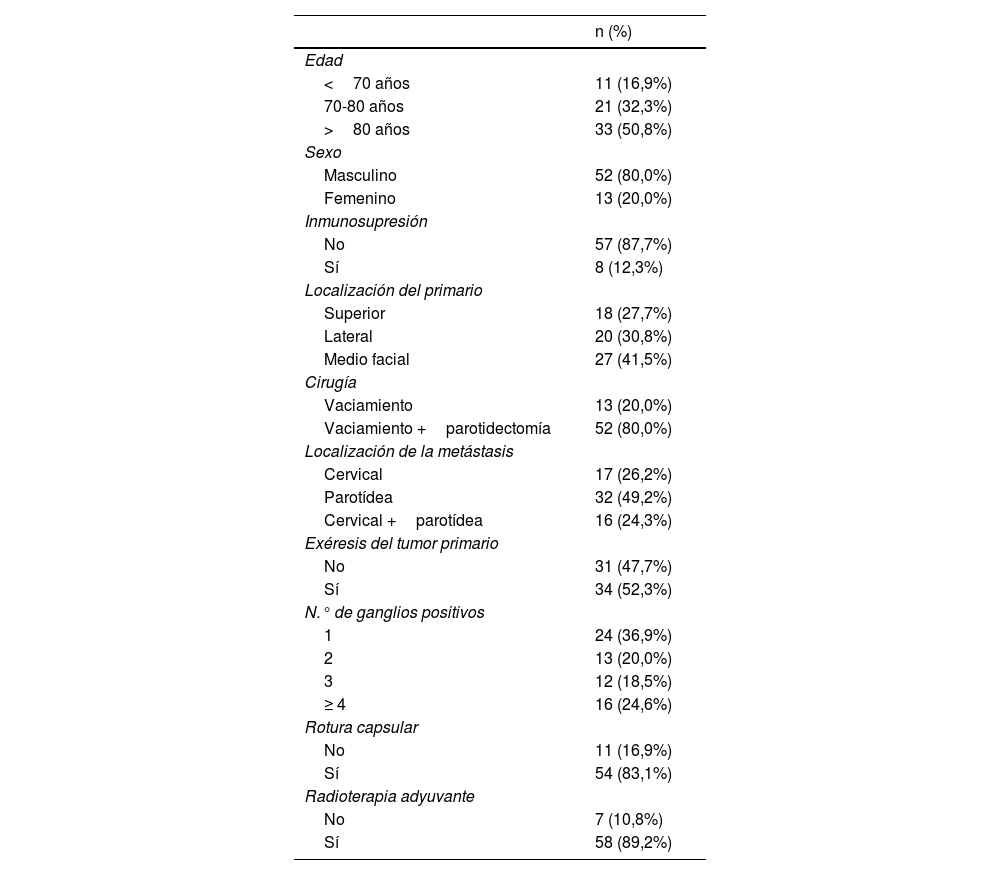El 2-4% de los carcinomas escamosos cutáneos localizados a nivel de cabeza y cuello (CECCC) dan lugar a la aparición de metástasis a nivel parotídeo o cervical. El objetivo del presente estudio es analizar los factores pronósticos de los pacientes con CECCC con afectación ganglionar tratados de forma quirúrgica, y comparar la capacidad pronóstica de la clasificación patológica de estos pacientes de acuerdo con la 8.ª edición del TNM y un método alternativo propuesto por O’Brien et al.
Pacientes y métodosRevisión retrospectiva de 65 pacientes con CECCC con afectación ganglionar tratados de forma quirúrgica durante el periodo 2000-2020.
ResultadosDurante el periodo de estudio se llevaron a cabo 13 vaciamientos cervicales y 52 parotidectomías +vaciamiento cervical en pacientes con metástasis ganglionares de CECCC. Una mayoría de pacientes (89,2%) recibieron radioterapia postoperatoria. La supervivencia específica a los 5años fue del 69,9%, y la supervivencia global, del 42,8%. El método de clasificación propuesto por O’Brien et al., basado en la localización parotídea o cervical de la metástasis ganglionar, el tamaño y el número de adenopatías metastásicas, contó con una mejor capacidad pronóstica que la clasificación de la 8.ª edición del TNM.
ConclusionesEl tratamiento quirúrgico de las metástasis ganglionares en pacientes con CECCC consiguió un elevado control de la enfermedad. La clasificación basada en la localización y el tamaño de las metástasis ganglionares propuesta por O’Brien et al. tuvo mejor capacidad pronóstica que la 8.ª edición del TNM.
Out of all cutaneous squamous cell carcinomas originating in the head and neck (HNCSCC), 2%-4% are associated with parotid or cervical lymph node metastasis. The aim of this study is to analyse the prognostic factors of patients with HNCSCC with lymph node involvement treated surgically. Additionally, we aim to compare the prognostic capacity of the classification of these patients according to the 8th edition of the TNM, and an alternative classification proposed by O’Brien et al.
Patients and methodsRetrospective review of 65 patients with HNCSCC with lymph node metastasis treated surgically during the period 2000-2020.
ResultsDuring the study period we carried out 13 neck dissections and 52 parotidectomies +neck dissection in patients with lymph node metastases from a HNCSCC. The great majority of patients (89.2%) received post-operative radiotherapy. The 5year disease-specific survival was 69.9%, and the overall survival it was 42.8%. The classification proposed by O’Brien et al., based on the parotid or cervical location of the lymph node metastases, and the size and number of the metastatic lymph nodes, had a better prognostic capacity than the TNM classification.
ConclusionsThe surgical treatment of lymph node metastases in patients with HNCSCC achieved a high disease control. The classification based on the location, size and number of lymph node metastases proposed by O’Brien et al. had better prognostic capacity than the TNM classification.












